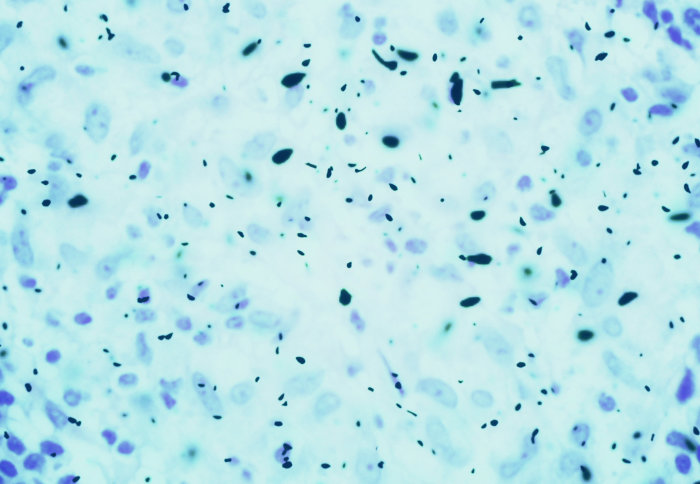Researchers develop new theory to explain random movement of particles in fluids

The new theory could help us understand how bacteria forage for nutrients in liquid
Mathematicians have developed a new theory to explain the strange, loopy motions seen in ‘passive’ particles immersed in ‘active’ fluids.
The theory could help researchers understand how microorganisms forage for nutrients, and how randomness arises in real-life, out-of-equilibrium systems like financial markets.
Einstein’s theory of Brownian motion, which describes the random movement of particles in fluids, is widely used to model randomness throughout science. However, this model only works when a fluid is static, or at equilibrium.
By swimming, microorganisms like bacteria and algae inject energy in the fluid and stir it up, which induces movement in the passive particles. Dr Andrea Cairoli Department of Bioengineering
In real-life environments, fluids often contain particles that move by themselves, such as tiny swimming microorganisms. These self-propelled swimmers can cause movement or stirring in the fluid, which drives it away from equilibrium.
Experiments have shown that non-moving ‘passive’ particles can exhibit strange, loopy motions when interacting with ‘active’ fluids containing swimmers. Such movements do not fit with the conventional particle behaviours described by Brownian motion and so far, scientists have struggled to explain how such large-scale peculiar movements result from microscopic interactions between individual particles.
Now researchers from Tsukuba University, École Polytechnique Fédérale de Lausanne, Imperial College London, and Queen Mary University of London, have presented a novel theory to explain observed particle movements in these dynamic environments.
They say the new model could help make predictions about real-life behaviours in biological systems, such as the foraging patterns of swimming algae or bacteria.

Co-author Dr Andrea Cairoli, who performed the work while part of Imperial’s Department of Bioengineering and is now at the Francis Crick Institute, said: “By swimming, microorganisms like bacteria and algae inject energy in the fluid and stir it up, which induces movement in the passive particles. Our work builds on various experimental results to construct a theory that can describe the motion of these passive particles comprehensively.”
Queen Mary University of London's Dr Adrian Baule, who managed the project, said: “Brownian motion is widely used to describe diffusion throughout physical, chemical and biological sciences; however it can’t be used to describe the diffusion of particles in more active systems that we often observe in real life."
By solving how the passive particles and active swimmers interact in the fluid, the researchers were able to derive an effective model for particle motion in ‘active’ fluids, which accounts for all experimental observations.
Their calculation reveals that the effective particle dynamics follow a so-called ‘Lévy flight', which is widely used to describe ‘extreme' movements in complex systems that are very far from typical behaviour, such as in ecological systems or earthquake dynamics.
The results are published in Nature.
Our results show that Lévy flights can arise as a consequence of the hydrodynamic interactions between the active swimmers and the passive particle, which is very surprising. Dr Kiyoshi Kanazawa University of Tsukuba
First author Dr Kiyoshi Kanazawa from the University of Tsukuba said: “So far there has been no explanation how Lévy flights can actually occur based on microscopic interactions that obey physical laws. Our results show that Lévy flights can arise as a consequence of the hydrodynamic interactions between the active swimmers and the passive particle, which is very surprising."
The team found that the density of active swimmers also affected the duration of the Lévy flight regime, suggesting that swimming microorganisms could exploit the Lévy flights of nutrients to determine the best foraging strategies for different environments.
Dr Baule added: “Our results suggest optimal foraging strategies could depend on the density of particles within their environment. For example, at higher densities active searches by the forager could be a more successful approach, whereas at lower densities it might be advantageous for the forager to simply wait for a nutrient to come close as it is dragged by the other swimmers and explores larger regions of space.
“However, this work not only sheds light on how swimming microorganisms interact with passive particles, like nutrients or degraded plastic, but reveals more generally how randomness arises in an active non-equilibrium environment.
"This finding could help us to understand the behaviour of other systems that are driven away from equilibrium, which occur not only in physics and biology, but also in financial markets for example.”
Credits:
Main image - Shutterstock
Image 2 - Kanazawa et al., Nature
“Loopy Lévy flights enhance tracer diffusion in active suspensions.” By K Kanazawa, T Sano, A Cairoli, and A Baule. Published 18 March 2020 in Nature.
This story is based on a press release from Queen Mary University of London.
Article text (excluding photos or graphics) © Imperial College London.
Photos and graphics subject to third party copyright used with permission or © Imperial College London.
Reporter
Caroline Brogan
Communications Division